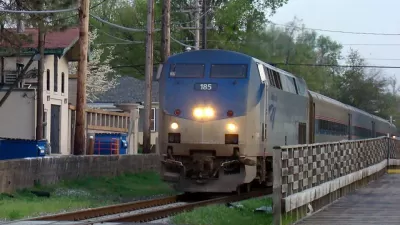Two transportation experts, Ken Orski, editor of Innovation Briefs and Joshua Schank, CEO of the Eno Center take opposing sides on whether it makes sense for the federal government to invest in high speed rail in this Wall Street Journal exclusive.
The Wall Street Journal editor poses the question, "Would funds for high-speed rail be better spent on improving existing intercity rail service?" While Orksi, editor and publisher of Innovation Briefs responds affirmatively, Schank does not deny the importance of improving existing rail service. "Yes, money is tight, and fixing what we already have would provide a greater immediate return. But isn't that always the case?", he asks.
However, Schank, President and CEO of the Eno Center for Transportation argues that incremental improvements are not enough, while Orski states that "until the U.S. regains its fiscal footing and has the financial resources to embark on a bold, capital-intensive endeavor, the federal government should forget about building a nationwide high-speed rail network and focus instead on modernizing existing rail infrastructure."
One of the main disagreements is whether the U.S. with its develolpment patterns would benefit from HSR as have Europe and Japan. Orski believes that only the Northeast Corridor should be considered while Schank cites travel statistics between Chicago and St. Louis to show how a "new high-speed rail line... could conceivably bring the travel time between the two cities down to less than 2.5 hours. After factoring in the challenges with airport security and traffic, this travel time would be highly competitive with airplanes and autos for people throughout both regions."
While Orski admits that the Northeast Corridor is a good candidate for HSR, he doesn't appear to support funding it other than "improving existing rail service-for instance, on signal systems, track alignments and station design."
Only "(w)hen the economy starts growing again, we might want to revive the idea of high-speed rail. Until then, prudence, good sense and the nation's well-being require that the federal government lower its sights", he concludes.
Schank ends his essay more optimistically.
"There is no doubt that building a high-speed rail network in the U.S. is an ambitious plan fraught with major funding and operational challenges. ...The U.S. can't afford to shy away from large investments out of fear. That is something second-rate countries do", he writes.
Two accompanying charts show rising Amtrak ridership since 2000 and "Amtrak's ten busiest lines in fiscal 2011 and their passenger counts".
The link to the article may be time-limited for those lacking WSJ electronic access.
Thanks to Mark Boshnack
FULL STORY: Would Funds for High-Speed Rail Be Better Spent on Improving Existing Intercity Rail Service?

Study: Maui’s Plan to Convert Vacation Rentals to Long-Term Housing Could Cause Nearly $1 Billion Economic Loss
The plan would reduce visitor accommodation by 25,% resulting in 1,900 jobs lost.

North Texas Transit Leaders Tout Benefits of TOD for Growing Region
At a summit focused on transit-oriented development, policymakers discussed how North Texas’ expanded light rail system can serve as a tool for economic growth.

Why Should We Subsidize Public Transportation?
Many public transit agencies face financial stress due to rising costs, declining fare revenue, and declining subsidies. Transit advocates must provide a strong business case for increasing public transit funding.

How to Make US Trains Faster
Changes to boarding platforms and a switch to electric trains could improve U.S. passenger rail service without the added cost of high-speed rail.

Columbia’s Revitalized ‘Loop’ Is a Hub for Local Entrepreneurs
A focus on small businesses is helping a commercial corridor in Columbia, Missouri thrive.

Invasive Insect Threatens Minnesota’s Ash Forests
The Emerald Ash Borer is a rapidly spreading invasive pest threatening Minnesota’s ash trees, and homeowners are encouraged to plant diverse replacement species, avoid moving ash firewood, and monitor for signs of infestation.
Urban Design for Planners 1: Software Tools
This six-course series explores essential urban design concepts using open source software and equips planners with the tools they need to participate fully in the urban design process.
Planning for Universal Design
Learn the tools for implementing Universal Design in planning regulations.
City of Santa Clarita
Ascent Environmental
Institute for Housing and Urban Development Studies (IHS)
City of Grandview
Harvard GSD Executive Education
Toledo-Lucas County Plan Commissions
Salt Lake City
NYU Wagner Graduate School of Public Service



























